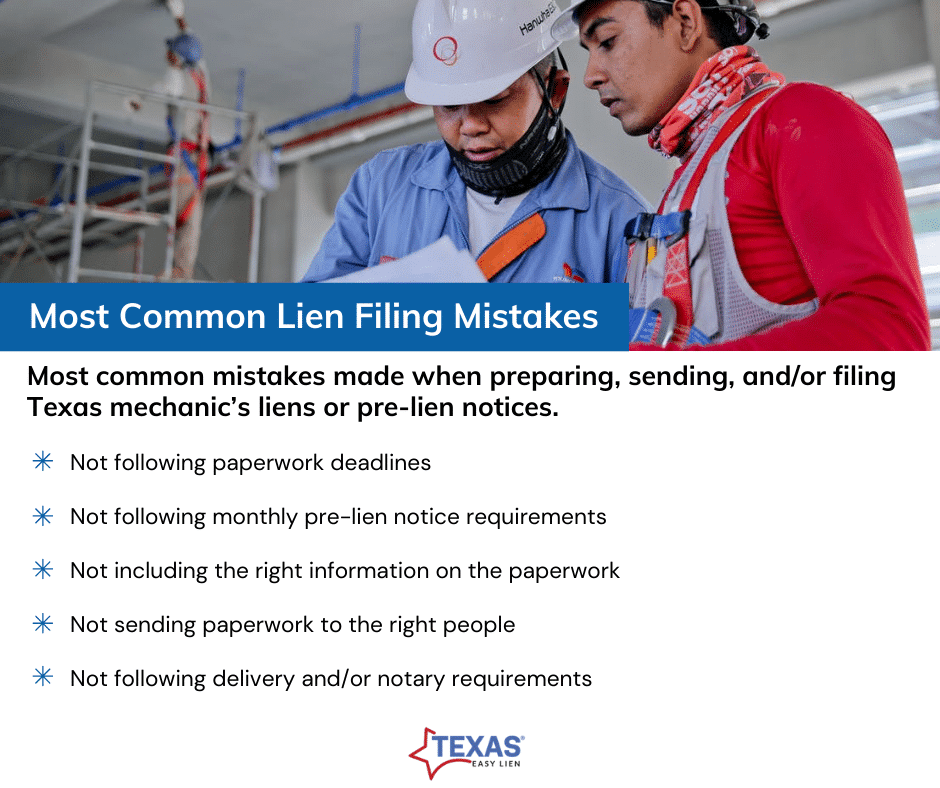Chasing after money owed when working in the Texas construction industry is nothing new. Despite the protection provided by Texas Construction Laws and the mechanic’s lien services, there are rules to follow to make them work for you.
Let’s look at some of the most common mistakes made when preparing, sending, and/or filing Texas mechanic’s lien or pre-lien notice (a.k.a. intent of lien notice) paperwork.

Not following paperwork deadlines
Most common and misunderstood are the Pre-Lien and Mechanic’s Lien affidavit deadline requirements. Not adhering to the deadlines will result in forfeiting your lien rights.
Not following monthly pre-lien notice requirements
The pre-lien notice (also called an intent of lien notice) is an official letter that alerts the general contractor and property owner that you (the subcontractor, sub-subcontractor, or material supplier) are not being paid for work performed.
Although essential to the lien filing process, sending a pre-lien notice does not mean a mechanic’s lien affidavit has to be filed. In fact, sending the pre-lien notice letter is often enough to prompt payment and resolve the issue. As mentioned before, the pre-lien notice is subject to deadlines, which you can find here in detail.
Not including the right information on the paperwork
Since non-payment for private commercial construction work in Texas is common, we highly recommend gathering the following information at each job begins so you’re prepared to protect your payment rights. This information is mandatory for completing any mechanic’s lien paperwork, including pre-lien notice letters.
- Project Information: Project owner, name of the project, common address (or legal property description), and county where the project is located.
- For Subcontractors: Name (or company name) and mailing address of the General (Prime) Contractor.
- For Sub-subcontractors: You must have the name and include the mailing address of all Subcontractors involved above you in the contract chain.
- Work: Invoice dates, description of the unpaid work performed (this can be general), and the amount owed for each individual month.
Not sending paperwork to the right people
Just as WHEN you send mechanic’s lien paperwork is essential, so is WHO receives it. For subcontractors, sub-subcontractors, and material suppliers, the pre-lien notice (and a copy of the mechanic’s lien affidavit if you file one) must be sent to both the General Contractor and Property Owner.
General Contractors filing a mechanic’s lien against a property owner are not required to send pre-lien notice letters – the GC is only required to send a copy of the lien affidavit to the property owner upon filing.
Not following delivery and/or notary requirements
Finally, let’s look at the paperwork delivery and notarization requirements under Texas construction law. Here’s a quick outline of the requirements for each document we’ve discussed:
Pre-lien notices
- Must be mailed to both the Property Owner and the General Contractor with Return Receipt Requested (RRR) – be sure and keep the RRR receipt from the post office as proof of sending. If there are other subcontractors above you in the chain of contract, then you must include them also.
Mechanic’s lien affidavit
- The lien affidavit must be signed, notarized, and filed in person at the county records office where the project is located.
- You must mail a copy of your lien affidavit to the property owner and general contractor by the 5th calendar day after filing the lien with the county. Otherwise, your lien could be invalidated.
Although this process may seem daunting, it’s pretty straightforward if you know the rules. We make filing any of this paperwork easy AND affordable at www.texaseasylien.com. We even offer online notarization!
More questions? Visit us at www.texaseasylien.com for answers. We’re here to help you protect your payment rights.


